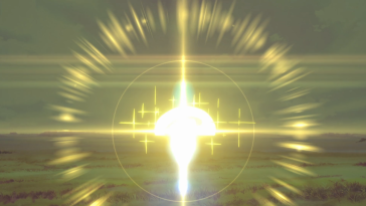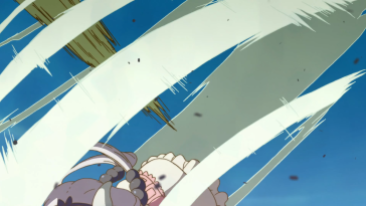The centerpiece of the second episode of Dragon Maid is a brief, yet electorate action cut filled to the brim with effect animation uncharacteristically (and not in a bad way!) flashy for KyoAni. The scene only lasts for half a minute but hits like a bellowing locomotive of visual style, displaying a remarkable level of technical competence. The entire cut is an amazing display of shapes and colors that morph and change to build the energy of the scene, improving on the few pages in chapter 9 of the manga. It begs the question, ‘Who came up with this?’ or better yet, ‘Who animated it?’
First thing we should do is look at the staff: credit to Ron at AnimeStyle
Script: Yuka Yamada (山田由香) Storyboard : Yasuhiro Takemoto (武本康弘) Episode Director: Shinpei Sawa (澤真平) Animation Direction: Yuki Tsunoda (角田有希), with Akiko Takase (高瀬亜貴子) assisting Key Animation Nami Iwasaki (岩﨑菜美) | Sana Suzuki (鈴木沙奈) | Ayaka Nagahama (長浜彩夏) | Shiho Morisaki (森崎志保) | Kyohei Ando (安藤京平) | Shinpei Sawa (澤真平)
So who would be in a position to embellish such a scene? With the way anime production is set up, only the Series Director, Series Composer, or the Episode Director or Storyboarder would be in a position to contribute such an additions. Examining each of the positions, the name Shinpei Sawa stands out in particular because not only is he the Episode Director, but also a Key Animator, making him a prime suspect for a number of reasons.
Shinpei Sawa is one of the few overtly effect oriented animators at Kyoto Animation capable of animation such as this. Sawa was mentored by on of the rare other KyoAni effects animators, Noriyuki Kitanohara. Kitanohara’s biggest tell is most noticeably the way his effects move, establishing a shape, retreating into the background of the shot before expanding into the foreground. His movement is fast paced and kinetic, snapping from on key frame to another, a.k.a. it relies on poses more than the movement between poses, and stands out from the more naturalistic character animation KyoAni specializes in with how flashy it can be. Sawa observed these techniques while studying animation at Kyoto Seika under Kitanohara before graduating in 2009 to immediately start work on as an inbetweener. When he was promoted to key animation he started to be recognized for his love for effect animation; again, a trait uncharacteristic of the studio.
Having stated his affinity for this exact type of animation in the past, and being in to position with his directorial debut able to add an effect heavy action scene to the episode, I think it’s safe to say our central action sequence is the brain child of Shinpei Sawa. Undoubtedly there was assistance from series director Yasuhiro Takemoto to plot the blocking and shot composition of the fight with his storyboards, since directing and animating at the same time can be a an extremely heavy workload. However, as tradition would hold, most Episode Directors don’t do key animation on their own episodes unless there is a scene that is incredibly important. And what could be more important than an added fight scene requiring specialized animation? In all likelihood, the battle between Tohru and Kanna was designed for Sawa to showcase his talents.
The first shot of the cut is reminiscent of Kitanohara’s style: establishing a shape, retreating into the background of the shot before expanding into the foreground (literally in the form of the blast’s impact wave). Sawa favors circular shapes for most of his effects which gives them a very playful feel. In frames 2 and 3 he very clearly he exhibits influence from Yoh Yoshinari, featuring his trademark starburst. In fact, the explosion itself feels like an overly cartooned version of the surreally violent Yoshinari explosion. The following shot with Kobayashi shows the debris of the blast being pushed in an even round plume, exposing Sawa’s bias towards roundness.
The next shot displays a sort of pose-to-pose-ness that Sawa learned from Kitanohara. Tohru draws back in one frame, the Kanada style flash moves across the screen to convey the movement, but the next frame features Tohru having already lunged. The actual animation is pose to pose, the flash frame conveying the movement without actually showing it. The momentum of the shot is supported by the first frame of Tohru’s hand adorned with exaggerated effects animation, smearing from rapid velocity as it takes a claw shape. This harkens to one of the 12 principles of animation: anticipation. We are fed the visual information that her hand is poised with visual energy in the first frame (it moves quickly – smears, and is full of energy – effects animation), so when we see the split-second flash cross the screen (3rd frame) the anticipation established by the claw is interpreted in our heads as movement despite the actual movement going from frame 2 to frame 4 with nothing in between.
As Kanna tosses Tohru we see more circular effects expanding as she smears out of the left side of the screen. Cut on action, and Tohru tears a circular hole in the clouds before Kanna forms her energy ball; another case of establishing a shape, retreating into the background of the shot before expanding into the foreground.
We see something similar with Tohru’s fireball. Sawa leads the cut with an impact frame that takes a round effect in the foreground, then becoming smaller before expanding again. This stagger is great for an effect like this because it builds anticipation. In the real world, the rules of volume and mass are much more rigid, whereas in animation they technically don’t exist at all. We expect most objects we encounter to have a constant size and shape, so when Tohru’s attack shrinks, it is against what we’ve learned living in reality. However, we do transpose the realism that as objects are compacted they become more dense which builds a sense of power. The color here really paints the scene with even more emotion, the ball going from pitch black to molten white. Tohru’s face is simplified and hugs the left third of the screen as not to distract from the forming blast.
Perfectly accenting abundance of rounded shapes is Sawa’s use of straight, precise lines for laser beams. A perfect example of this the 2nd frame, where Kanna’s blast parts the smoke and debris in color design that pops and moves your eye around the screen. A gentle camera shake complements the ferocity of the animation, making it all the more vivid as bright colors erupt across the frame.
The fight between Tohru and Kanna is a remarkable scene that steals the show. It’s an excellent showcase of Shinpei Sawa’s trademark tells and how he operates as an animator. Breaking down the animation like this not only us gives greater insight into the mind of the artist, but also to the technicality of animation. Recognizing an artist is a worthwhile pursuit, and often times the the highest honor we as fans can give them. There is nothing more rewarding than watching such an amazing display of artistry unfold before you like this one – but akin to it appreciating those who made it.





















Awesome writing piece!
This sequence is one of the fav of the season so far for me, is just a great showdown of animation for a animator that i actually quite love, even did a animator spotlight on him before the episode, he’s just awesome, and i hope that he get more episodes to direct on the future, he’s heading to be one of the best directors of Kyoto Animation!.
LikeLiked by 1 person
Reblogged this on Lenny & Friends Art Cartel and commented:
I can appreciate this not as an anime fan but as an amateur animator. Check this out!
LikeLiked by 1 person